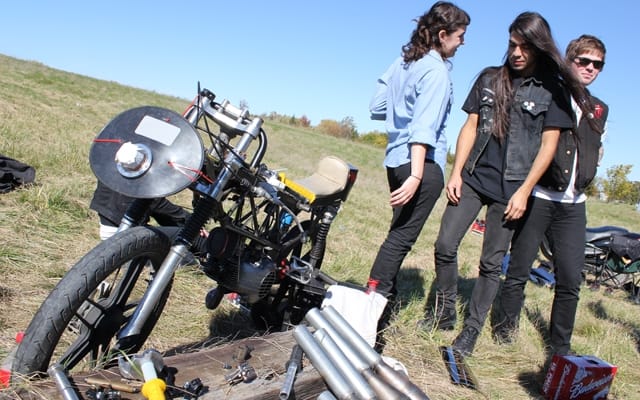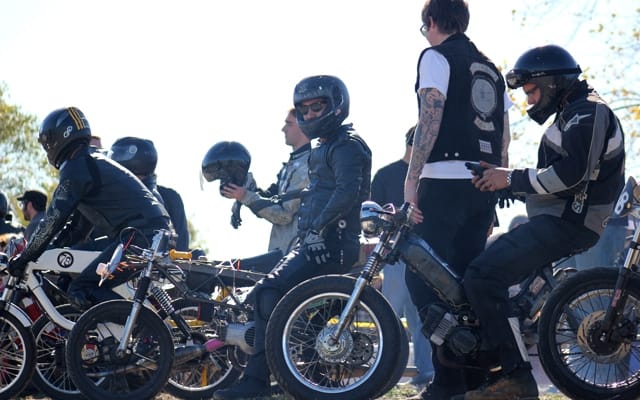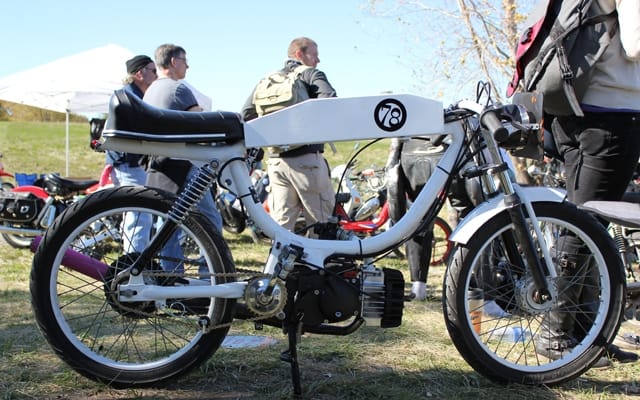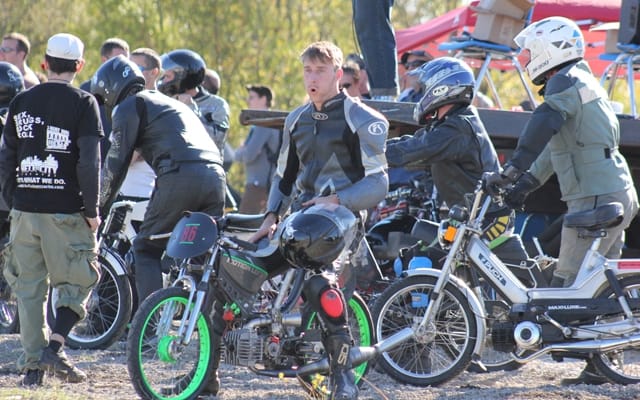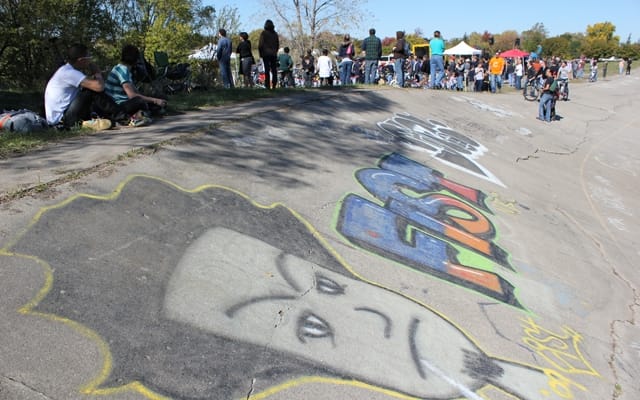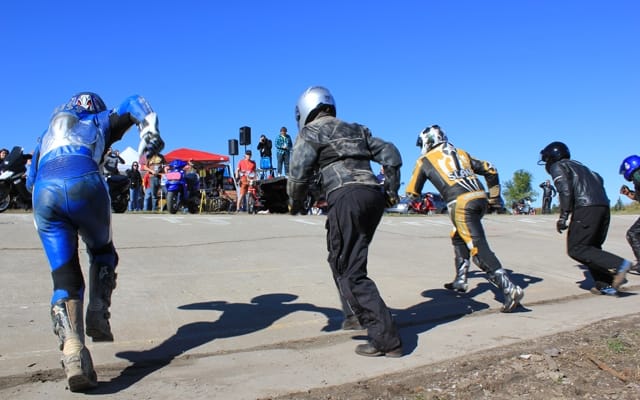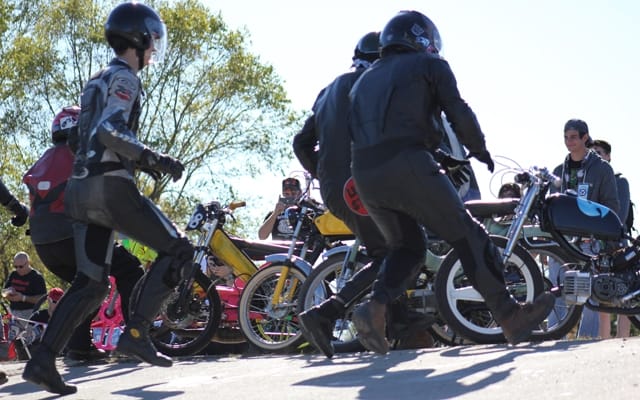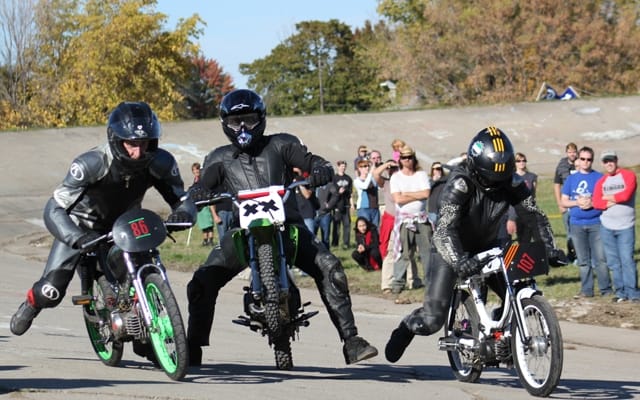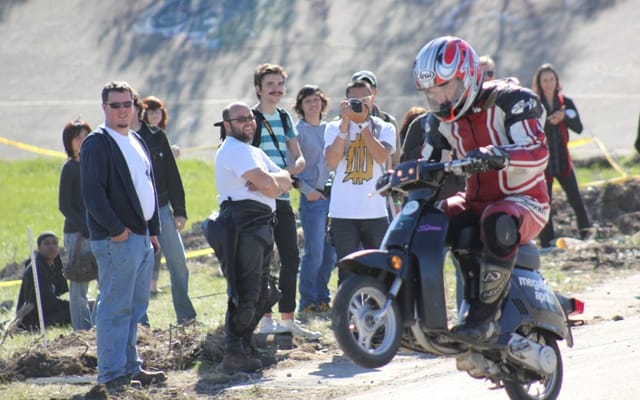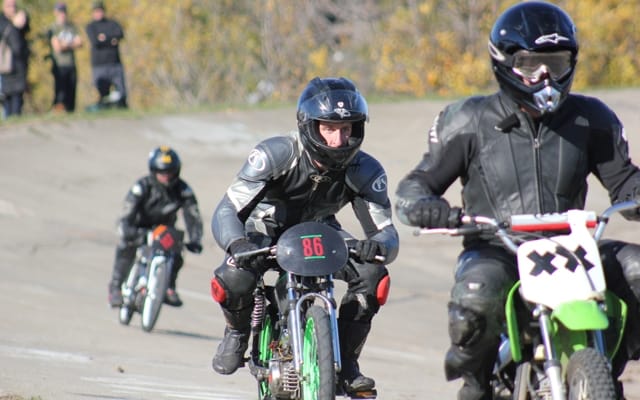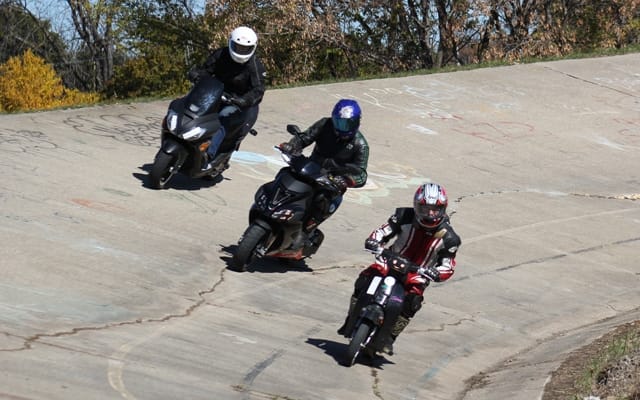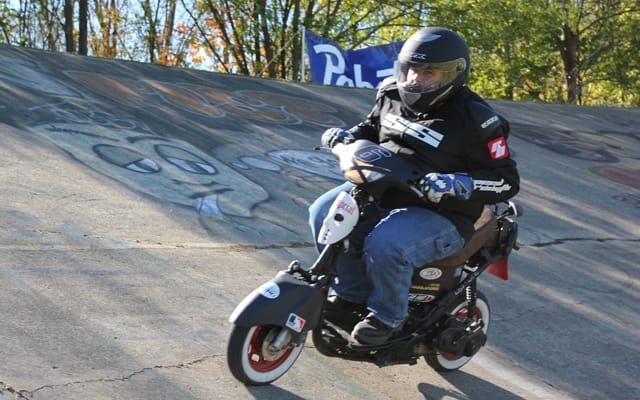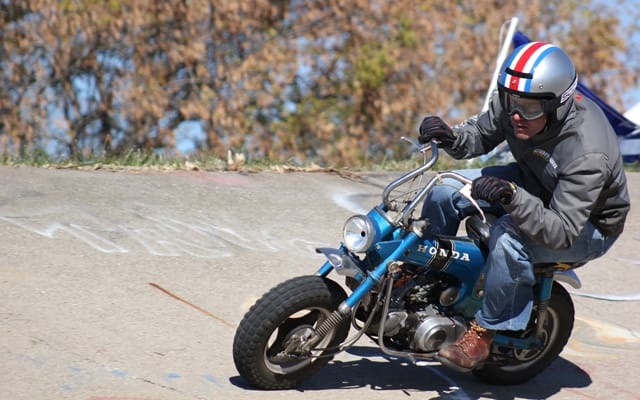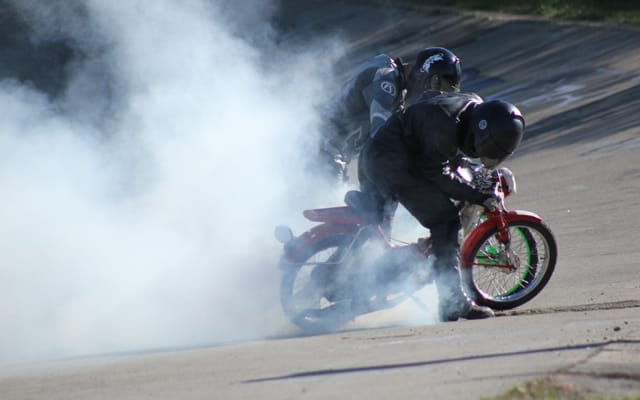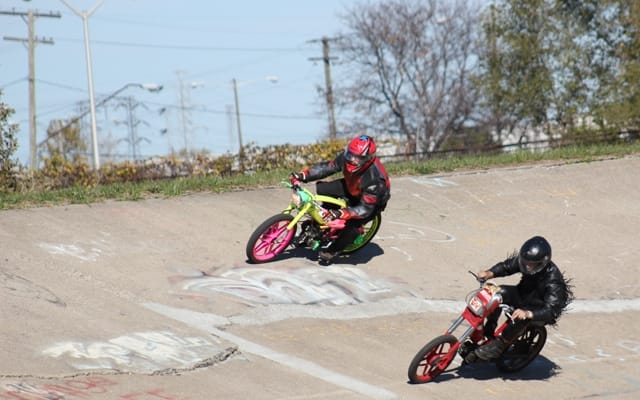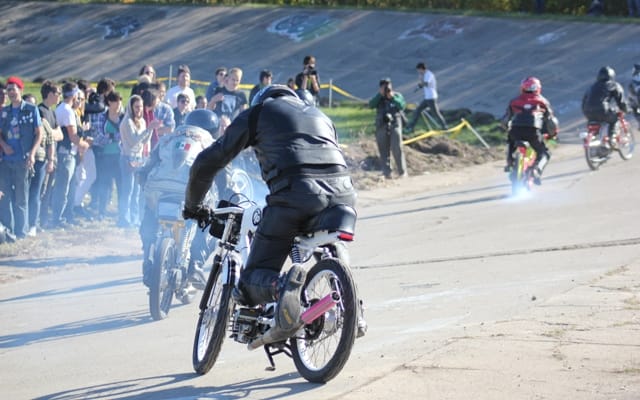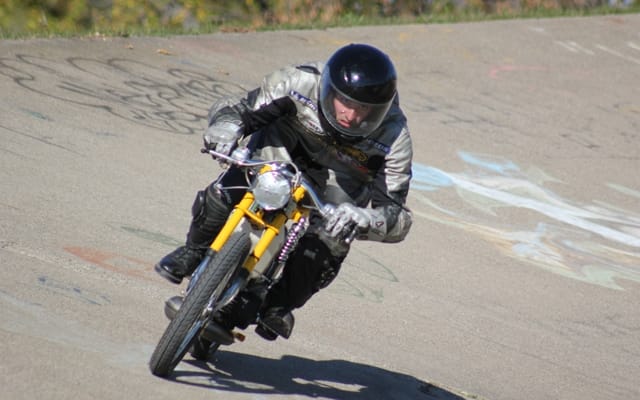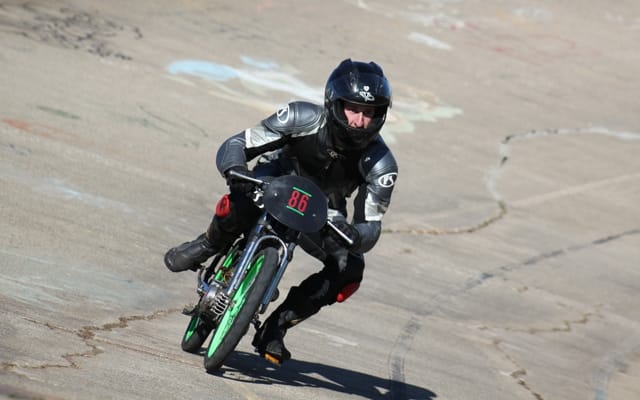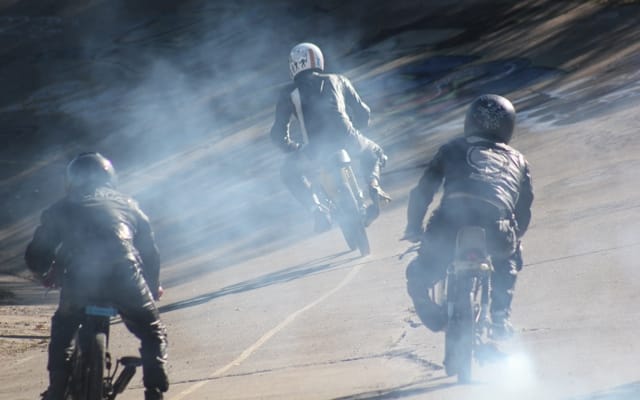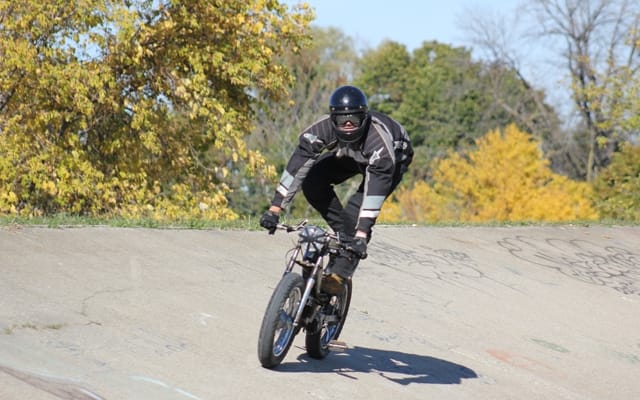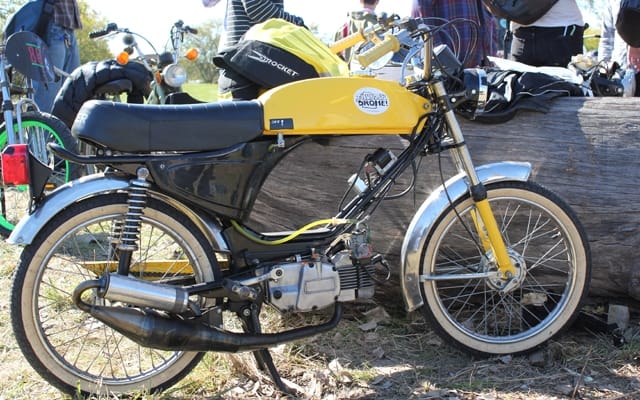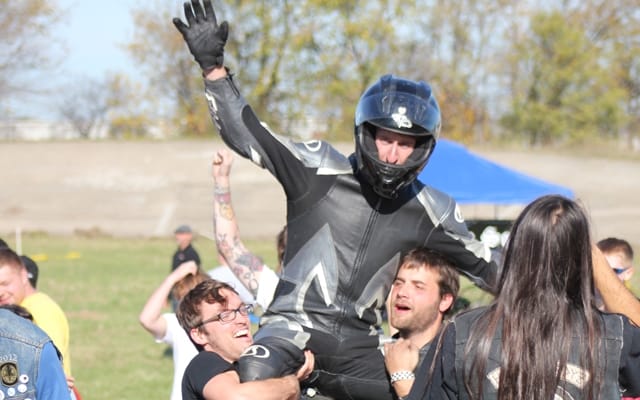Something is happening in Detroit besides murder and decay. As improbable as it sounds, life is returning to the Motor City — one semi-legal moped race at a time.
On my private fear-factor scale,“lost in Detroit” ranks just below “the phone call is coming from inside the house.” So when I realize we’ve taken a wrong turn, cold sweat trickles down my back.
The plan had been straightforward: cross into Detroit from Windsor, Ontario, on the Ambassador Bridge, take Interstate 75 to Eight Mile, and then ride east to Mound Street. We take the correct exit, but in navigating road construction we turn onto a service road and miss one of Detroit’s most famous thoroughfares.
I ignore a nervous shoulder tap from my wife and soldier on, hoping to hit a major street. The road becomes rougher and neighbourhoods gloomier with each passing block. Houses are boarded up, or burned. Garbage is strewn across lawns. Most disturbingly, it’s completely deserted. This sad, neglected place was once a working class neighbourhood filled with tidy clapboard bungalows and busy families. We ask a road construction crew for directions, and one or two illegal turns later we’re back on track to Eight Mile and Mound.We’ve had a taste of Detroit’s dark side—now it’s time to have some fun. We’re headed to Thunderdrome.
The brainchild of local motoring enthusiasts Andy Didorosi and Ben Wojdyla, Thunderdrome is billed as a “balls-out wheel-to-wheel race for geared road bikes, fixies, mountain bikes, scooters, pit bikes and mopeds.” The venue is an old velodrome that has lain beneath weeds in Detroit’s Dorais Park for almost 30 years. Recently uncovered and restored to semi-functioning order, it’s a wicked-looking concrete oval filled with ruts, heaves, potholes and covered in ’80s-era gang graffiti.
It’s a hilarious concept—the kind of event that can only happen in a place like Detroit, where law enforcement has bigger issues to confront than a subversive race that flaunts zoning bylaws. And it illustrates what has become a consensus among local bloggers: Detroit, with its crime, poverty, and decay, is poised for a comeback—things are happening again in America’s saddest and baddest city.
When we pull into the park, a handmade sign that reads simply “Drome” points the way over a grassy hill. We ride past a No Vehicles sign along a well-worn trail. As we crest the rise the morning’s anxieties are washed away in a fragrant cloud of two-stroke smoke. Thunderdrome has attracted a crowd of several hundred, a mix of hipster gearheads and curious locals. Music blares from a sound system mounted on a flat bed truck, where Andy Didorosi, a charismatic twenty-something wearing a flannel shirt, hi-top sneakers and a badge that reads “El Jefe,” hands out t-shirts. Surrounding the truck are a handful of vendor tents selling t-shirts, courier bags, and more t-shirts. A harried crew from a local fast-food joint passes platters of nachos and sodas to the crowd. Throughout the rolling hills of the park that surround the velodrome, racing teams are scattered. They have brought a motley assortment of machinery, from 50cc scooters in girlish pink to stripped and heavily modified mopeds. There are no high-powered full-size motorcycles—and that’s a good thing. A big bike at speed would be suicidal on this track, given its cramped size and nasty surface. A chat with Thom Suzumoto of Chicago’s Hot and Readies moped club reveals that practice runs have been interesting. “It’s hard to take those banked turns when you’ve never been on a velodrome before,” says Thom. “I started pushing it a bit and I went over the edge.” I ask if he meant over the top. He did. “Yeah, I landed on my head and banged up my knee. I had to rebuild the forks and handlebar this morning. Good thing none of the organizers saw anything.”
From his roost on top of the flatbed, Didorosi asks spectators to clear the track for the first heat of the scooter race. For the LeMans start, racers waddle across the track on foot in creaking leather suits, start their mounts, and then waddle off down the track. It’s obvious that some have racing backgrounds. One rider, whose scoot bears the moniker “Megabuck Aprilia,” goes high around his foes on the first turn and takes off to an early lead. Others race with style rather than speed. One scooter has red wheels, whitewall tires, and a goalie mask strapped to the front.
The scooters are fun to watch, but their flexible frames and rudimentary suspension are no match for the velodrome’s fissured, pockmarked surface. Watching them bounce and wobble around the track quickly grows boring. I have higher hopes for the pit bike class. My patience is rewarded.
Despite the previously declared 50 cc displacement limit, all of the bikes are illegal. A black-clad rider on a Kawasaki KX 110 tears into the lead. Close on his heels is an open-piped KTM minimotocross and a ’70s Yamaha GT80 two-stroke with a Honda Trail 70 bringing up the rear. Speeds are impossible to estimate, but fast enough to send Andy into fits.“Oh God, I’m getting scared,”he yells into the microphone. “This is very, very fast. People, move back from the edge of the track!”
The KTM and the Kawasaki trade high and low positions on the banked corners before the green machine roars to victory. The speeds claim one victim before the race is over—the Yamaha of Kevin Callaway seizes and chucks him head first into the dirt mounds that ring the track. Callaway, a WERA and AMA racer from Detroit, is bruised but otherwise unhurt, and happy for the opportunity to race his pit bike. “This is the first bike I owned,” he says. “I couldn’t pass up the chance to get it on a track.”
A series of bicycle races gives us time for a plate of greasy nachos and a cold Faygo. Between races a go-kart fitted with a compressed-air-powered cannon and fashioned into a giant Twinkie fires the golden snack cakes into the crowd.
There is a thriving community of moped racing fanatics in the U.S., and some of the heaviest hitters are here. This, clearly, is the day’s main attraction. In truth, the bikes barely resemble mopeds anymore. The very best of them look like lightweight 1960s-era Italian racing motorcycles, with lean, sculpted frames and tiny motors tuned just short of breaking. They buzz the track like wasps, diving into turns with enormous corner speed with riders’ knees skimming the track surface.
The fastest moped rider is Devin Biek, proprietor of Motion Left Mopeds of Goshen, Indiana. Biek’s bike is a marvel, a delicate, spindly contraption with clip-on handlebars, avocado-green wheels and a savage-sounding open pipe. In a field of hot-shoes Biek puts on a dominating performance, coupling perfect cornering lines with a clear power advantage. I corral Biek at the end of the race to ask about the bike, which is, of all things, a 1978 JC Penny Pinto.
Biek proudly rattles off the long list of performance modifications. “The pipe is custom-fabricated. I went through eight of them to find just the right one for this track,” he says. “It’s got a 74 cc Gilardoni piston and cylinder, a performance crank, performance clutch, custom porting, 24 mm flat-slide carb and electronic ignition.” Biek pauses for a moment, struggling to remember the rest of his very long list. He smiles when I ask how much horsepower it makes. “I’ve never dynoed it, but I think it’s between 10 and 12 horsepower. Stock it makes about two.”
And then the showdown. Promoter Didorosi challenges Biek to put his moped up against the KLX 110 that won the pit bike class. Biek agrees and lines up next to the Kawasaki and a moped pilot given a second chance after an earlier mechanical failure. A giddy Didorosi warms the crowd with a warning: stand back from the track or risk “a trip to the hospital with a moped through your sternum.”
The signal is given and they’re off. The Kawasaki’s inadvertent wheelie off the line hands the lead to Biek, but the Kawasaki’s horsepower makes the advantage short lived. What follows is a brilliant five-lap cat and mouse game, with half a dozen changes for the lead—three in the last lap alone. The pit bike and the moped are neck-and-neck on the back straightaway on the last lap, until Biek pulls ahead and enters the last turn way up high. The Kawasaki stays low and takes the lead, but can’t maintain the tight line. As the pit bike drifts upward on the track Biek plunges down to the inside and wins by a wheel.
Following the awards ceremony (the Powder Puff winner receives a gift certificate from Vibrators.com) Didorosi and business partner Wojdyla reflect on Thunderdrome, which Didorosi freely admits was “a joke that grew into a huge thing.”“The velodrome was discovered by a volunteer group called The Mower Gang that’s cleaning up Detroit’s abandoned parks,” says Didorosi. “When we first saw it, we thought it would be great to take our mini bikes around. Then we decided to make an event out of it for our friends. Once the Detroit News put us on the front page everything exploded.”
Thunderdrome became a labour of love, requiring three weeks of excavation and repair on the track itself and the surmounting of some serious bureaucratic hurdles, including threat of arrest from the Parks Department. But in the end, even they got on board. For Didorosi and Wojdyla, it’s further proof that Detroit is changing. “I’ve been living here the better part of 12 years,” says Wojdyla. “Right now it seems like there’s an odd vibe—a confluence of cheap land, lack of policing, and a do-it yourself culture.”“I think Detroit is the truest expression of the American dream,” says Didorosi. “Your success or failure is completely dependent on your skills, not who you know. People are moving here from places like San Francisco. Smart people, creative people, who want to live in a place where they can make a difference.”
Their optimism is heartfelt, but perhaps a bit naive given the urban blight we stumbled through that very morning. Detroit is still a deeply troubled city, and it’s easy to be cynical about its chances for recovery. And then I recall a house in a desolate neighbourhood from earlier in the day. It was rundown but occupied, and its front yard was crowded with large-scale wooden carvings of animals and totem poles. A small thing. Just one house. But something. A flicker of creativity and pride, a love note to the city, even there, amid the ruins.
